This article was co-authored by Pippa Elliott, MRCVS. Dr. Elliott, BVMS, MRCVS is a veterinarian with over 30 years of experience in veterinary surgery and companion animal practice. She graduated from the University of Glasgow in 1987 with a degree in veterinary medicine and surgery. She has worked at the same animal clinic in her hometown for over 20 years.
wikiHow marks an article as reader-approved once it receives enough positive feedback. In this case, 91% of readers who voted found the article helpful, earning it our reader-approved status.
This article has been viewed 109,500 times.
In the winter months, it's important to keep your rabbit safe and warm. Cold weather can lead to health problems like colds and respiratory infections. You should strive to create a warm environment for your rabbit and make sure he gets adequate water and exercise. Take certain precautions, like avoiding electronic blankets, to prevent injury and accident.
Steps
Creating a Warm Environment
-
1Make adjustments to your rabbit's hutch. During the winter months, your rabbit will need to stay warm. You'll need to make certain adjustments to his hut to make sure it's hospitable for your rabbit.
- If possible, the easiest adjustment you can make is to simply move the hutch somewhere warmer. If you can bring it indoors or to a heated garage, this is ideal.[1]
- Check for any gaps in the hutch's wall. It's not uncommon for rain and other weather conditions to wear down a hutch. Wood may also be old and rotting. If you see any damages, apply rabbit-safe wood protectant coating. You can also line the hutch with newspaper to keep cold air from entering through any gaps.[2]
- If your rabbit hutch has mesh doors, cover them in clear plastic wrap. This will allow your rabbit to see through the hutch doors while preventing air from entering. However, leave a small gap towards the bottom for proper ventilation.[3]
-
2Insulate the hutch. You want to insulate your rabbit's hutch during winter. To do this, place sheets of newspaper and a warm blanket on the roof. Then, cover in an outdoor tarp. Not only will this trap heat and keep the hutch adequately warm, it will prevent snow or rain from falling on your rabbits.[4]Advertisement
-
3Provide a warm bed. Rabbits need warm beds year-round, but especially in the winter. There should be some kind of box in your rabbit's hut with an entry hole the rabbit can climb in and out of. You can buy a rabbit bed at a pet store or online. You can also make your own out of a cardboard box.
- During winter, line the floors and walls of a rabbit's bed with newspaper. This will help insulate the bed and keep your rabbit warm.[5]
- Place a lot of bedding material in the sleeping area. You can use dust-free hay as bedding. Avoid giving your rabbit a blanket in his bed. Rabbits may chew on blankets, which can cause intestinal blockage.
-
4Add straw. When it comes to keeping rabbits warm, straw is one of the best materials. Place straw throughout the cage. Pack straw towards the edge of the hut, adding insulation, and place a bit of straw inside the rabbit's sleeping area. Make sure to change straw every few days. Rabbits may urinate on the straw and you do not want your rabbit sleeping in dampened material.[6]
Caring for Your Rabbits
-
1Make sure water bottles and bowls don't freeze. In the winter months, water bottles and water bowls can potentially freeze. This will leave your rabbit without water, which he needs even in the winter.
- Check water bottles and bowls a few times a day. If they freeze, replace them promptly.[7]
- Insulating water bottles can reduce their risk of freezing. You can wrap a water bottle in an old towel. You can also buy water bottles designed for winter use, which come wrapped in materials that keep them warm.[8]
- Make sure to have lots of spare bottles handy. Plastic bottles especially may crack in the winter months. You do not want your rabbit to go without water in the event his bottle breaks.[9]
-
2Dry rabbits if they play in the snow. If your rabbits sometimes play outdoors, they may get wet in the snow. You want to make sure to dry your rabbits off before putting them back in their hut. Dry your rabbits with a towel. If they're still wet, let them warm up indoors. Allow them to dry indoors naturally. Do not put them by a heater to dry.[10]
-
3Keep rabbits in pairs. If you have more than one rabbit, try to keep them in pairs over the winter. This will both provide socialization and help keep your rabbit warm. Rabbits can snuggle with one another in the winter months for heat.[11]
- If you haven't introduced rabbits, take some time with the introduction process before winter. It may take awhile for rabbits to get comfortable with one another. Make the first introduction in neutral space, like a room in your home. Rabbits are territorial and throwing them in a cage together right away can be a disaster.[12]
- Introduce the rabbits in 20 minute increments. In the event of fighting, separate them and then try again in an hour or so. You can use a water bottle to break up fights.[13]
- Keep your rabbits in eye contact with each other when they're not interacting. Once they seem comfortable with one another in a neutral space, you can try caging them together for short periods. Eventually, you should be able to move your rabbits into the same cage for the longterm.
- Some rabbits may simply not get along, even with your best efforts. If your rabbits continually fight, it's better not to cage them together. If rabbits get aggressive or territorial, they could injure one another.[14]
-
4Clean the cage regularly during colder months. As it grows colder, make sure you regularly clean your rabbit's cage. Urine can cause bedding, straw, and hay to dampen and even freeze. This can cause health problems if not dealt with properly. Remove any clumps of urine from your rabbit's cage on a daily basis, paying special attention to his bedding area.[15]
Taking Precautions
-
1Be careful with heated blankets. Many pet stores sell heated blankets to keep rabbits warm during the winter. If you choose to use these, practice extreme caution. Do not leave your rabbit unsupervised with an electronic blanket. There's a risk of electric shock if a rabbit chews through the cords. They could also potentially cause a fire if left near hay, newspaper, or flammable material.[16]
-
2Keep baby rabbits indoors. A baby rabbit's body temperature needs to be around 100 °F (38 °C). It's nearly impossible to keep a baby rabbit adequately warm outside during the winter. If you have babies, you must keep them inside for their safety.[17]
- The first 10 days of a rabbit's life are especially crucial. If the temperature is below 50 degrees, it's very difficult for a baby rabbit to stay warm enough to survive.[18]
- It's a bad idea to let rabbits breed during winter. However, if your rabbit ends up having babies in the winter months, you should bring the mother and babies indoors.[19]
-
3Make sure your rabbits exercise over the winter. Rabbits do not hibernate in the wild. A period of inactivity for the winter months is not natural for them. Therefore, you need to take steps to make sure your rabbits get exercise even in the winter.
- Consider bringing your rabbits inside to play. This will prevent his coat from getting wet with snow. If you have a rabbit-safe room in your home, bring your rabbit indoors a few times a week to let him run and play.[20]
- However, be careful not to let your rabbit spend too much time indoors. Rabbits develop thick coats in the winter to protect them from the cold. If your outdoor bunny spends too much time inside, he could start losing his coat. This puts him at risk for a variety of health problems.[21]
-
4Watch for signs of health problems. With proper precautions, your rabbit should be safe and healthy over the winter months. However, be on the lookout for signs of health problems. If your rabbit has a cold or respiratory problem, he should be evaluated by a vet and kept indoors. Watch for the following:
- Discharge from the nose
- The appearance of dirt around the nose
- Discharge from the eyes
- Loud breathing[22]
References
- ↑ http://www.saveafluff.co.uk/rabbit-info/winter-care-for-rabbits
- ↑ http://www.saveafluff.co.uk/rabbit-info/winter-care-for-rabbits
- ↑ http://www.therabbithouse.com/outdoor/rabbitwinter.asp
- ↑ http://www.saveafluff.co.uk/rabbit-info/winter-care-for-rabbits
- ↑ http://www.therabbithouse.com/outdoor/rabbitwinter.asp
- ↑ http://rabbitbreeders.us/keeping-rabbits-warm
- ↑ http://www.rabbitrehome.org.uk/care/winter.asp
- ↑ http://www.rabbitrehome.org.uk/care/winter.asp
- ↑ http://www.rabbitrehome.org.uk/care/winter.asp
- ↑ http://www.saveafluff.co.uk/rabbit-info/winter-care-for-rabbits
- ↑ http://www.saveafluff.co.uk/rabbit-info/winter-care-for-rabbits
- ↑ http://rabbit.org/faq-bonding-multiple-rabbits/
- ↑ http://rabbit.org/faq-bonding-multiple-rabbits/
- ↑ http://rabbit.org/faq-bonding-multiple-rabbits/
- ↑ http://www.saveafluff.co.uk/rabbit-info/winter-care-for-rabbits
- ↑ http://rabbitbreeders.us/keeping-rabbits-warm
- ↑ http://rabbitbreeders.us/keeping-rabbits-warm
- ↑ http://rabbitbreeders.us/keeping-rabbits-warm
- ↑ http://rabbitbreeders.us/keeping-rabbits-warm
- ↑ http://www.rabbitrehome.org.uk/care/winter.asp
- ↑ http://www.rabbitrehome.org.uk/care/winter.asp
- ↑ http://www.rabbitrehome.org.uk/care/winter.asp
About This Article
To keep a rabbit warm, start by moving its hutch indoors during colder months. If you can’t bring the hutch into a heated area, cover the mesh doors with plastic wrap, leaving a small gap at the bottom for ventilation. Additionally, insulate the hutch by placing sheets of newspaper and a warm blanket on the roof, and cover it with an outdoor tarp. Next, provide warm bedding, like a newspaper lined box, and add straw throughout the cage. For more tips from our Veterinary reviewer, including how to keep baby rabbits warm in the winter, keep reading!
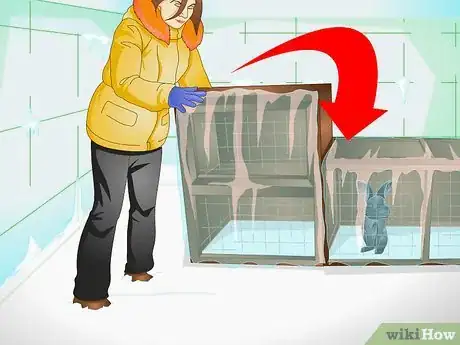

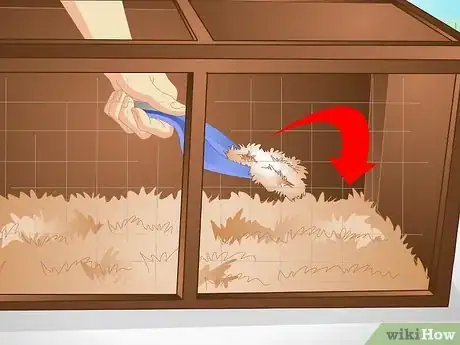

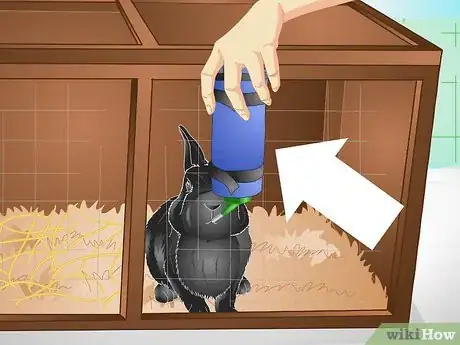

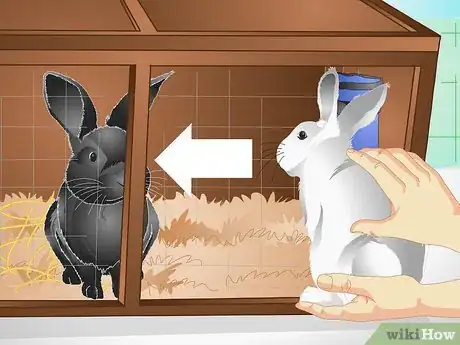

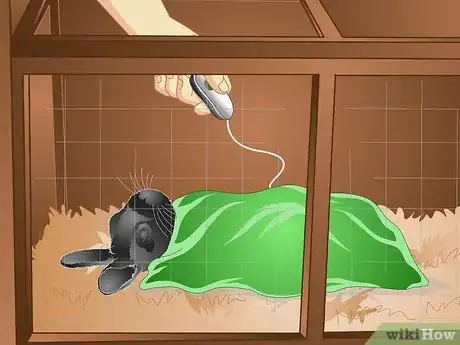
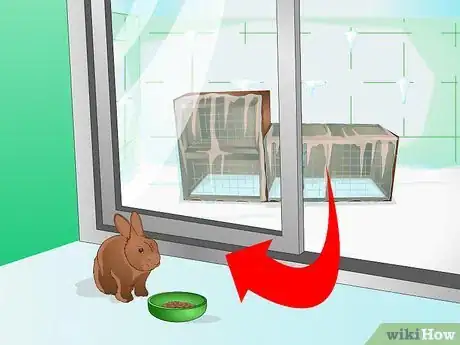

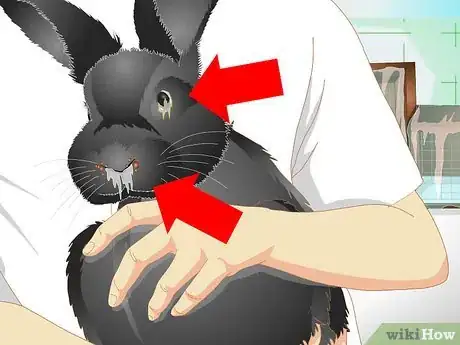












-in-Rabbits-Step-12.webp)
















































